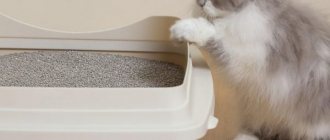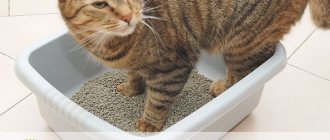Bladder catheterization in a cat is the only way to save the life of a pet in case of acute urinary retention. Most often, such an emergency condition of an animal occurs due to urolithiasis. With this pathology, stones disrupt the normal flow of urine and cause bladder overflow. If catheterization is not carried out in a timely manner to remove the accumulation of urine from the organ, it will stretch to the limit, and at some point the walls of the bladder will burst due to excessive stretching. It is almost impossible to save a cat in such an emergency situation.
Sometimes catheterization is needed to flush the bladder for therapeutic purposes. Placement of a catheter for any purpose is carried out only by a doctor.
© shutterstock
Why is a catheter placed?
Urinary retention in a cat (obstruction) is the result of plugs of inflammatory material, mucus, crystals, small stones that have formed in the kidneys and entered the bladder. The causes of inflammatory materials and stone formation are not fully understood.
The obstructive structure in pets is a sandy plug of mucus and sand that forms in the bladder over time. Pets may experience difficulty urinating regardless of age. The anatomy of the end of the cat's urethra is narrow. As the condition progresses to complete blockage of urine, the symptoms become more intense.
If left untreated, urinary blockage will cause kidney failure and death within 24 to 48 hours. To save a life, it is necessary to immediately insert a catheter into the cat. The dimensions of the device depend on the size and gender of the pet. In males, the penile area is trimmed with a surgical blade.
The medical device is used by veterinarians to flush the bladder or administer quick-acting medications. The doctor will prescribe an x-ray to confirm inflammation of the excretory system and identify stones that contribute to the obstructive process.
Further studies with catheterization:
- Imaging of the urinary tract.
- Pressure measurement (urodynamics).
- Determination of the width of the excretory canal.
After the therapeutic procedures, the doctor will prescribe treatment and tell you how to put an IV in your cat.
What it is?
Catheterization of the bladder in cats is necessary for the treatment of urolithiasis, cystitis and other pathologies of the genitourinary system. The procedure can only be performed by a veterinarian, as a person without special knowledge can cause serious injury to the penis or urethra.
With the help of catheterization, you can introduce the necessary medications into the organ, alleviate the cat’s condition, and also take urine for further research. The event, carried out in a veterinary clinic, is harmless to the animal, since only experienced doctors are allowed to perform it.
Indications for catheterization
Inflammation of the kidneys and intestines are the main indications for catheterization. A blocked bladder increases potassium levels (hyperkalemia), which affects the heartbeat and can lead to the death of your pet. Once a urinary obstruction is identified, emergency treatment and stabilization are required.
Catheterization is performed for:
- Diagnosis of urolithiasis.
- One-time urine collection for analysis if excretion through cystocentesis is not possible.
- Inclusions of contrast agent during examinations.
- Obstruction therapy.
If your cat has chronic kidney disease, the urethra may need to be dilated. This procedure is designed to provide a permanent opening that allows crystals, mucus plugs, or small stones to pass out of the urethra.
In most cases, a dose of general or local anesthesia is administered before the procedure. Infection of the renal pelvis, kidney stones, and chronic renal failure are possible consequences of recurrent urethral obstruction.
When is the procedure performed?
Inserting a urethral catheter for a kitten and an adult is required not only for urolithiasis, but also for other pathological conditions in which the pet does not urinate. Veterinarians prescribe catheterization in case of mechanical damage to the cat’s bladder. Indications for which a urological catheter is required are the following situations:
- Conservative treatment for urolithiasis. This therapeutic technique can be used for pathology once or regularly to facilitate urine excretion.
- Impaired urine flow during acute illness. When abnormalities in the urinary system worsen, the cat is prescribed catheterization for emergency bladder emptying.
- Surgical intervention. After surgery in the area of the urinary system, it is difficult for the pet to walk when necessary, so a catheter is installed. When the muscles are restored, the cat will be able to urinate on its own.
- The need to rinse the cat's urethra and bladder. This measure is carried out during treatment, with its help it is easier to deliver medicines to the affected organs.
- Determination of urination volume and urine collection. Catheterization is performed in a short time, and after the study the catheter is removed.
- For diagnostic purposes. If a cat or kitten needs to take X-rays of the urinary system, then catheterization is performed, through which a contrast agent is injected.
Technique
If pathological processes are detected in an animal, it may be necessary to rinse the bladder. The doctor will perform the procedure as follows:
- To relieve pain, the male needs sedation or general anesthesia. Clinicians use local aerosol analgesics (Lidocaine Asept (spray), Carmolis).
- Sterile lubricant is placed on the tip of the tube. An atraumatic tip lubricated with a synthetic lubricant is inserted into the lumen of the urethra. If the device cannot pass through the excretory duct, the veterinarian will drain the animal's bladder by placing a needle on the outside and releasing the urine using a syringe.
- Once the first 2 cm of the catheter is in the penile urethra, the non-dominant hand is used to pull the preputial opening caudally to continue insertion of the tube.
- When regulating water and electrolyte metabolism in an animal, parenteral fluid therapy is performed. The infusion volume is 45-68 ml of crystalloid per kilogram of body weight over 30 minutes.
- Removal of obstructive materials is carried out using solutions that destroy plugs and mucus clots.
- Surgery may be required to remove stones from the organ to prevent inflammation from recurring.
- When the device completely enters the excretory channel, liquid begins to be released from the tube. The clinician determines the condition of the organ by color, consistency and smell.
- Blood clots are eliminated using a solution of novocaine.
- Cats with life-threatening arrhythmias secondary to hyperkalemia are treated immediately with sodium bicarbonate (stimulation of intracellular potassium metabolism) or calcium gluconate (stabilization of the heart and changes in threshold potential).
If necessary, leave the instrument for several days. The veterinarian prescribes medication and diet therapy at home.
Preparation
As a rule, before starting the procedure, the specialist carries out a number of preparatory measures, which include:
- Research for contraindications and reasons for catheterization. If this procedure is not possible, other methods of removing urine from the organ are chosen as treatment.
- Anesthesia. It is necessary so that the pet does not feel pain during all manipulations. Without pain relief, the cat can harm both itself and the veterinarian. Sedation or general anesthesia is most often used. The first option applies to pets with lack of appetite, severe intoxication, various functional disorders and a prolonged course of the disease. The second option is used in animals whose condition is assessed as satisfactory, without severe intoxication and without heart and vascular diseases. Catheterization of the bladder in cats without anesthesia is carried out only in the case of an extremely serious condition of the animal.
- Hygienic measures. Before the procedure, the hair from and around the penis is shaved, and the skin is disinfected. This is necessary to prevent pathogenic microflora from entering the bladder.
- Additional pain relief. Various local aerosol analgesics are used as local anesthesia. This further reduces sensitivity, since the head of the penis contains many nerve endings. Without analgesia, the cat will feel pain even under anesthesia.
Catheter care rules
An indwelling urinary catheter is a flexible plastic tube that is inserted through the opening of the urethra to drain urine. The instrument is held in place by a small balloon, and prolonged catheterization is often performed. Only a veterinarian can place the tube correctly.
Home care:
- Check the area around the urethra for inflammation or signs of infection, such as irritated, swollen skin where the tube was inserted.
- The drainage bag should be placed below the level of the bladder.
- Clean the area around the drainage tube twice a day.
- The catheter and drainage tube should not be bent.
- The product must not be left open.
- Empty the liquid collection bag promptly.
- In case of contamination, rinse the device with warm boiled water.
The connection of the catheter to the sterile drainage system creates a closed system that cannot be opened. Antibacterial drugs will help to avoid infection by reducing the likelihood of developing an infection. Improper removal of the medical device may result in injury to the animal's excretory system. To avoid this, you need to know how to remove a cat's catheter.
Removing the urinary catheter
A Faley catheter is a thin tube that drains urine into a special bag. Its removal is necessary in cases where :
- the catheter stops functioning;
- the animal has suffered an injury to the urethra or bladder;
- The problem causing the device installation has been resolved.
The procedure for its removal is carried out only by a veterinarian. You should not try to carry out such an operation at home by watching videos from the Internet. Removing the catheter on your own can result in injury to the mucous membrane of the urinary tract.
Caring for the animal after catheterization
After completing the manipulations, the veterinarian will examine the condition of the tube. If kinks or dents are detected in the system, there is a possibility of injury. The dye used in the procedure is excreted from the body by the kidneys. Antispasmodics are prescribed to relieve unpleasant symptoms.
At home, care involves observation. Before increasing the daily amount of fluid consumed, you should consult a veterinarian, because... the animal may have problems urinating. A burning sensation in the urethra occurs when urine is released the first few times. If your pet's discomfort lasts longer, it is a sign of infection. Post-obstructive diuresis is a common complication requiring immediate hospitalization.
To diagnose the causes of discomfort and examine your pet, you need to call a doctor at home.
All information posted on the site is provided in accordance with the User Agreement and is not a direct instruction to action. We strongly recommend that before using any product, you must obtain a face-to-face consultation at an accredited veterinary clinic.
Installation of a catheter and IV
Basic Rules
Before installation, it is necessary to bleed the air from the system.
- It is allowed to use solutions only at room temperature.
- The feed speed is set to low: standard - a drop in 2-4 seconds;
- emergency - 1 drop. in 5-6 sec.
Preparatory stage
Prepare all solutions and necessary medicine for administration through the catheter. To do this, measure the dosage. Lay out the system, needles, sterile wipes. The tube must be clamped with a roller clamp by turning the regulator all the way down. Hang the bag with the solution upside down. It is better to place it at a height of 1-1.5 meters. Insert the needle into the feed cap and squeeze the filter with your fingers to fill it halfway with liquid. Open the clamp and wait until the tube is completely filled with the solution until the first drops appear from the needle or cannula. Close the system and check for bubbles. If there is any, dribble some more liquid through the tube.
System installation for a cat
The algorithm for infusion into a vein is as follows:
Once the catheter is inserted, the system can be connected.
- Shave the puncture site and disinfect with alcohol. This is often done between the elbow and wrist joints of the forelimb.
- Lay the cat on its side and secure it.
- Apply a tourniquet or bandage the paw slightly above the puncture site.
- Bend and straighten the limb to allow blood to flow.
- Carefully insert the needle (catheter). If everything is correct, a couple of drops of blood will appear in the instrument. It is important that there are no bumps or redness at the puncture site. Secure with adhesive tape.
- Connect the system and set the speed.
If you need to place an IV at the withers, the preparation steps are the same as if you administer the solution intravenously. For a small kitten, it is better to use a butterfly needle. Insert it to its entire length, open the clamp and set the speed - 1 drop. in 1-2 sec. Veterinarians warn that no more than 20 ml per 1 kg of cat weight is allowed in one place. After the procedure, a swelling appears under the skin, soft to the touch. It should resolve after 2-8 hours.
Catheterization: how to behave at home?
Most of us have seen patients in the hospital walking around with a bag of urine hanging on a stand. But in most cases they leave the hospital without it. However, sometimes the healing process after surgery or injury takes a long time, so patients are discharged home with a catheter. How do they live with it every day?
In principle, patients with a catheter can lead a normal life, that is, do light exercise, walk around the house, go for a walk or even go to work (the urine bag can be attached using special Velcro straps to the inner thigh).
Fixation of the catheter
However, if you have such a device, you need to get plenty of rest and remember to follow a few rules:
- First of all, you need to be careful with hygiene. Wash your hands thoroughly with soap and water before emptying the bladder or replacing it with a new one. It is also important to take care of intimate hygiene by washing the perineum and the outside of the catheter at least once a day with soap and water to prevent the migration of microorganisms into the urinary tract.
- For the same reason, you should not unnecessarily disconnect the bag from the drain hole.
- It is necessary to empty the urine bag regularly because urine is a good breeding ground for microorganisms.
- People with a catheter should drink more, preferably disinfectant herbal infusions, drinks rich in vitamin C, such as blackcurrant juice, cranberry juice. Low urine pH limits the growth of microbes.










